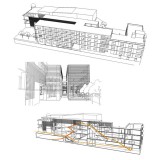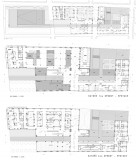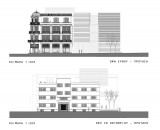Supervisors:
Architectural Design
History and Theory of Architecture and Art
2008
The building complex of Matsagos belongs to the University of Thessaly and it is situated in the centre of the town-planning tissue of the city of Volos and constitutes a reference place for the local community and its size allows multiple activities.For all these reasons, we decided the reuse of the complex as a place which is addressed to the creative and artistic needs of the students, which is simultaneously open to the public of Volos in a more vivid and conciliatory relationship between the University and thecity.
The building programme includes workshop, exhibition and manifestation spaces, banquet and hospitality spaces as well as spaces of artistic activities, converting the Matsagos complex into a powerful pole of attraction.
The building complex was developed in four phases. The continuous and gradual expansion has as a result a “matching” of buildings with different morphological and territorial particularities. The sights of the complex are preservable as well as the Matsagos arcade.
We are aiming at unifying and modulating the outdoor spaces of the complex, which include the university square, to the beautiful blocks, through a unified gesture preserving the arcade at the same time.
Thus, we decided to make a “surgical” section to the building creating an intermediate space between the two produced “new pieces” of the building. The necessity of preservance of the arcade led us to the design of a course which passes underneath it and to the space defining of the public places to the end levels of the building. These spaces are unified with an uninterrupted ascent to the limit of the section while the descent is fulfilled gradually through the intermediate floors which are characterised by a bigger level of privatisation.
With the “surgical section”, the interior of the building with the existing hemp of the organization, acquires elements of exterior space. The section becomes the sight and functions as an element of orientation. The meaning of this sight is enhanced as it is charged as an “epidermis” with its own character which organizes the movement to its limits.
Epidermes with different expressions (sight, walls, separated panel, furniture) “include” movements and define spaces. They respectively define levels of privatization and inwardeness in relation to the movement of the human body, the use of the space and the level of transparency of their materials.
The prearranged movement course of the human body in the space organizes the form and the functions of the building and vice versa; the way in which the space is structured is reflected to the way of movement inside it.
The “recess” of the building is expanded as engraving and as a ramp to the square, which “descends” gradually in order to create an open stage and functions as an open space in which the public converses – in a unified sense – with the new character of the building complex.





